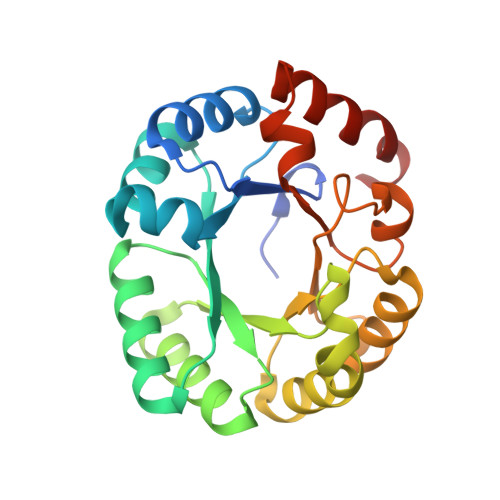Mechanism of the orotidine 5'-monophosphate decarboxylase-catalyzed reaction: importance of residues in the orotate binding site.
Iiams, V., Desai, B.J., Fedorov, A.A., Fedorov, E.V., Almo, S.C., Gerlt, J.A.(2011) Biochemistry 50: 8497-8507
- PubMed: 21870810
- DOI: https://doi.org/10.1021/bi2012355
- Primary Citation of Related Structures:
3NQC, 3NQD, 3NQE, 3NQF, 3NQG, 3NQM, 3PBU, 3PBV, 3PBW, 3PBY, 3PC0 - PubMed Abstract:
The reaction catalyzed by orotidine 5'-monophosphate decarboxylase (OMPDC) is accompanied by exceptional values for rate enhancement (k(cat)/k(non) = 7.1 × 10(16)) and catalytic proficiency [(k(cat)/K(M))/k(non) = 4.8 × 10(22) M(-1)]. Although a stabilized vinyl carbanion/carbene intermediate is located on the reaction coordinate, the structural strategies by which the reduction in the activation energy barrier is realized remain incompletely understood. This laboratory recently reported that "substrate destabilization" by Asp 70 in the OMPDC from Methanothermobacter thermoautotrophicus (MtOMPDC) lowers the activation energy barrier by ∼5 kcal/mol (contributing ~2.7 × 10(3) to the rate enhancement) [Chan, K. K., Wood, B. M., Fedorov, A. A., Fedorov, E. V., Imker, H. J., Amyes, T. L., Richard, J. P., Almo, S. C., and Gerlt, J. A. (2009) Biochemistry 48, 5518-5531]. We now report that substitutions of hydrophobic residues in a pocket proximal to the carboxylate group of the substrate (Ile 96, Leu 123, and Val 155) with neutral hydrophilic residues decrease the value of k(cat) by as much as 400-fold but have a minimal effect on the value of k(ex) for exchange of H6 of the FUMP product analogue with solvent deuterium; we hypothesize that this pocket destabilizes the substrate by preventing hydration of the substrate carboxylate group. We also report that substitutions of Ser 127 that is proximal to O4 of the orotate ring decrease the value of k(cat)/K(M), with the S127P substitution that eliminates hydrogen bonding interactions with O4 producing a 2.5 × 10(6)-fold reduction; this effect is consistent with delocalization of the negative charge of the carbanionic intermediate on O4 that produces an anionic carbene intermediate and thereby provides a structural strategy for stabilization of the intermediate. These observations provide additional information about the identities of the active site residues that contribute to the rate enhancement and, therefore, insights into the structural strategies for catalysis.
- Departments of Biochemistry and Chemistry, University of Illinois, Urbana, Illinois 61801, United States.
Organizational Affiliation:


















